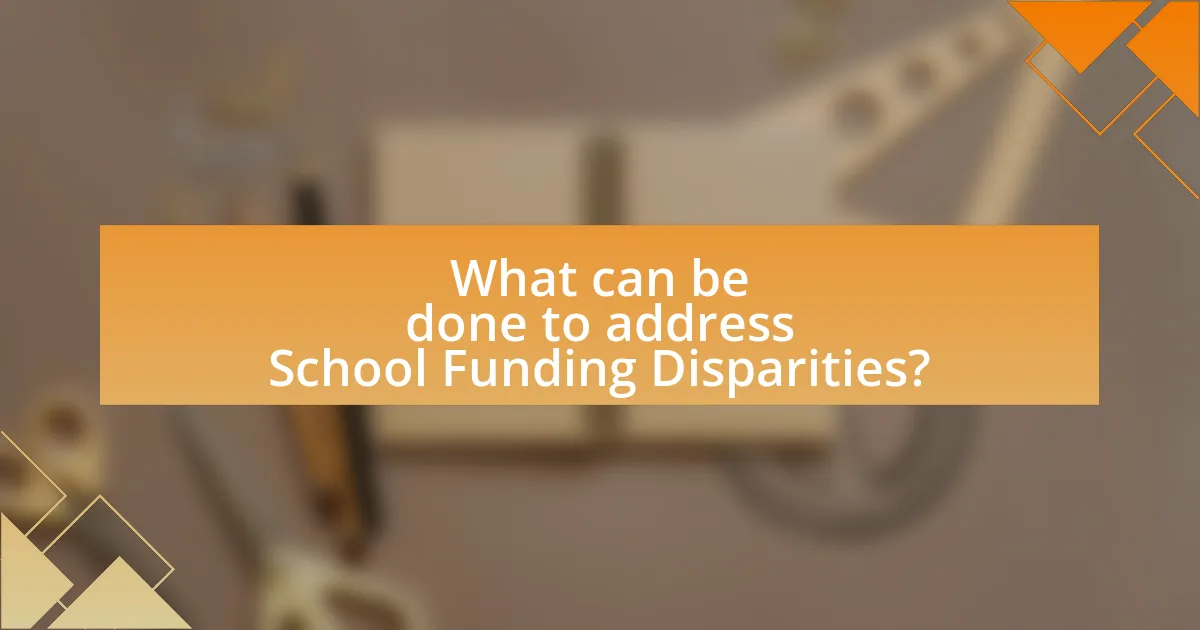School funding disparities refer to the unequal allocation of financial resources among educational institutions, primarily influenced by local property taxes, state funding formulas, and the socioeconomic status of communities. These disparities lead to significant differences in educational quality, access to advanced courses, and overall student support services, particularly affecting low-income and minority students. The article examines how these funding inequities arise, their impact on student opportunities, and the long-term effects on educational outcomes, including graduation rates and college readiness. It also discusses potential strategies and policy changes to address these disparities and improve funding equity across schools.

What are School Funding Disparities?
School funding disparities refer to the unequal distribution of financial resources among schools, often influenced by factors such as local property taxes, state funding formulas, and socioeconomic status of the communities. These disparities result in significant differences in educational quality, access to advanced courses, extracurricular activities, and overall student support services. For instance, a report by the U.S. Department of Education in 2019 highlighted that schools serving predominantly low-income students receive about $1,000 less per student than those serving wealthier populations, illustrating the financial inequities that affect educational opportunities.
How do School Funding Disparities arise?
School funding disparities arise primarily from differences in local property tax revenues, which are often the main source of funding for public schools. Wealthier communities can generate more revenue through property taxes, leading to better-funded schools, while lower-income areas struggle to provide adequate funding due to lower property values. According to the U.S. Department of Education, schools in high-poverty areas receive about $1,000 less per student than those in affluent neighborhoods, highlighting the significant impact of local funding mechanisms on educational equity. Additionally, state funding formulas can exacerbate these disparities by allocating resources based on local wealth rather than student needs, further entrenching inequalities in educational opportunities.
What factors contribute to unequal school funding?
Unequal school funding is primarily influenced by local property taxes, state funding formulas, and socioeconomic disparities. Local property taxes account for a significant portion of school funding, leading to disparities between affluent and low-income areas; for instance, schools in wealthier neighborhoods often receive more funding due to higher property values. Additionally, state funding formulas can perpetuate inequality by allocating resources based on factors that do not account for the varying needs of different districts. Socioeconomic disparities further exacerbate funding inequalities, as schools in lower-income areas may struggle to attract additional resources or donations, resulting in fewer educational opportunities for students.
How do local, state, and federal policies impact funding disparities?
Local, state, and federal policies significantly impact funding disparities by determining the allocation of financial resources to educational institutions. Local policies often rely on property taxes, leading to unequal funding based on community wealth, while state policies can either mitigate or exacerbate these disparities through funding formulas that may favor certain districts. Federal policies, such as Title I funding, aim to support low-income schools but can be limited in scope and effectiveness, often resulting in insufficient resources to bridge the gap. For instance, a report from the U.S. Department of Education in 2020 indicated that schools in high-poverty areas receive about $1,200 less per student than those in low-poverty areas, highlighting the direct correlation between policy decisions and funding inequities.
Why are School Funding Disparities significant?
School funding disparities are significant because they directly impact the quality of education that students receive. Research indicates that schools in wealthier areas often have access to more resources, including advanced courses, experienced teachers, and extracurricular activities, compared to schools in lower-income neighborhoods. For instance, a report by the U.S. Department of Education found that schools serving predominantly low-income students receive about $1,000 less per student than those serving wealthier populations. This funding gap leads to unequal educational opportunities, affecting student performance and long-term outcomes, such as college readiness and career prospects.
What are the long-term effects of funding disparities on education quality?
Funding disparities lead to significant long-term effects on education quality, including reduced academic achievement, limited access to advanced coursework, and decreased resources for students. Schools in underfunded areas often struggle to provide essential services, resulting in lower graduation rates and diminished college readiness. For instance, a study by the National Center for Education Statistics found that schools with higher funding levels typically have better student performance metrics, such as standardized test scores and graduation rates. Additionally, disparities in funding contribute to inequitable access to experienced teachers and extracurricular programs, further exacerbating educational inequalities over time.
How do funding disparities affect different demographics?
Funding disparities significantly affect different demographics by exacerbating educational inequalities. For instance, schools in affluent areas often receive more funding through local property taxes, leading to better resources, experienced teachers, and advanced programs. In contrast, schools in low-income neighborhoods typically face budget cuts, resulting in larger class sizes, outdated materials, and fewer extracurricular activities. According to a report by the U.S. Department of Education, schools serving predominantly minority students receive about $23 billion less in funding than those serving mostly white students, highlighting the systemic inequities in educational funding. This disparity ultimately limits opportunities for students from underfunded demographics, impacting their academic performance and future prospects.

How do School Funding Disparities impact Student Opportunities?
School funding disparities significantly limit student opportunities by creating unequal access to educational resources and quality instruction. Research indicates that schools in affluent areas receive substantially more funding than those in low-income neighborhoods, often leading to better facilities, advanced coursework, and experienced teachers. For instance, a report from the U.S. Department of Education shows that schools serving predominantly low-income students receive about $1,000 less per student than their wealthier counterparts. This funding gap results in fewer extracurricular activities, limited access to technology, and inadequate support services, ultimately hindering academic achievement and future career prospects for students in underfunded schools.
What opportunities are affected by funding disparities?
Funding disparities primarily affect educational opportunities, including access to quality teachers, advanced coursework, extracurricular activities, and essential resources like textbooks and technology. Research indicates that schools in low-income areas often receive significantly less funding, leading to larger class sizes and fewer specialized programs. For instance, a report by the National Center for Education Statistics shows that schools serving predominantly low-income students receive about $1,000 less per pupil compared to their wealthier counterparts, which directly impacts student achievement and college readiness.
How do disparities influence access to advanced courses and extracurricular activities?
Disparities significantly influence access to advanced courses and extracurricular activities by creating unequal educational environments. Schools in affluent areas often have more resources, enabling them to offer a wider range of advanced courses and extracurricular programs, while underfunded schools may lack these opportunities. For instance, a report by the National Center for Education Statistics indicates that schools in high-poverty areas are less likely to offer Advanced Placement courses compared to those in low-poverty areas, limiting students’ ability to engage in rigorous academic experiences. Additionally, disparities in funding can lead to fewer extracurricular activities, as schools with limited budgets may prioritize basic educational needs over enrichment programs. This inequity ultimately affects students’ academic trajectories and college readiness, perpetuating cycles of disadvantage.
What role does funding play in student support services?
Funding is crucial for student support services as it directly influences the availability and quality of resources provided to students. Adequate funding allows schools to hire trained staff, implement effective programs, and offer essential services such as counseling, tutoring, and extracurricular activities. Research indicates that schools with higher funding levels can provide more comprehensive support services, leading to improved student outcomes, including higher graduation rates and better academic performance. For instance, a study by the National Center for Education Statistics found that schools with increased funding were able to reduce student-to-counselor ratios, enhancing personalized support for students.
Why do funding disparities lead to unequal educational outcomes?
Funding disparities lead to unequal educational outcomes because schools with less funding often lack essential resources, experienced teachers, and advanced programs. Research indicates that schools in low-income areas receive significantly less funding, which directly impacts the quality of education provided. For instance, a study by the Education Trust found that schools serving predominantly students of color receive about $23 billion less than those serving mostly white students, resulting in larger class sizes, outdated materials, and fewer extracurricular opportunities. Consequently, these factors contribute to lower academic performance and reduced college readiness among students in underfunded schools.
How do disparities affect graduation rates and college readiness?
Disparities in school funding significantly impact graduation rates and college readiness. Schools with inadequate funding often lack essential resources such as qualified teachers, advanced coursework, and extracurricular programs, which are critical for student development. For instance, a report by the National Center for Education Statistics indicates that students in low-funded schools are less likely to complete advanced placement courses, which are vital for college preparedness. Consequently, these students face lower graduation rates; data shows that high schools in low-income areas have graduation rates approximately 10% lower than those in affluent districts. This lack of resources and support ultimately leads to diminished college readiness, as students from underfunded schools often score lower on standardized tests, further hindering their chances of college admission.
What evidence exists linking funding levels to student performance?
Research indicates a strong correlation between funding levels and student performance. For instance, a study by the National Bureau of Economic Research found that increased school funding significantly improves student outcomes, particularly for low-income students. Specifically, the study revealed that a 10% increase in per-pupil spending can lead to a 7% increase in high school graduation rates and a 10% increase in college enrollment rates. Additionally, the 2018 report from the Learning Policy Institute highlighted that schools with higher funding levels are better equipped to provide essential resources, such as smaller class sizes and access to advanced coursework, which directly contribute to improved academic performance. These findings consistently demonstrate that adequate funding is crucial for enhancing educational opportunities and outcomes for students.

What can be done to address School Funding Disparities?
To address school funding disparities, implementing equitable funding formulas that allocate resources based on student needs is essential. Research indicates that states with weighted funding formulas, which provide additional resources for low-income and special needs students, have seen improved educational outcomes. For example, a study by the Education Trust found that states like Massachusetts and New Jersey, which utilize such formulas, demonstrate higher student performance compared to those relying on property taxes. Additionally, increasing state and federal investment in education can help bridge the funding gap, as evidenced by the significant improvements in schools that received increased funding through initiatives like the Every Student Succeeds Act.
What strategies can be implemented to reduce funding disparities?
To reduce funding disparities, implementing equitable funding formulas that allocate resources based on student needs is essential. These formulas can consider factors such as socioeconomic status, special education requirements, and English language proficiency, ensuring that schools serving disadvantaged populations receive adequate support. Research from the Education Trust indicates that states with weighted funding formulas, which allocate more funds to schools with higher needs, have seen improvements in student outcomes. Additionally, increasing state and federal investment in education can help bridge the funding gap, as evidenced by the National Center for Education Statistics, which reports that higher funding levels correlate with better educational performance.
How can policy changes improve funding equity?
Policy changes can improve funding equity by reallocating resources to ensure that underfunded schools receive adequate financial support. For instance, implementing weighted funding formulas that account for student needs, such as socioeconomic status and special education requirements, can direct more funds to schools serving disadvantaged populations. Research from the Education Trust indicates that states that adopted such formulas saw a significant reduction in funding disparities, leading to improved educational outcomes for students in low-income areas. By prioritizing equitable funding mechanisms, policy changes can create a more balanced educational landscape, ultimately enhancing opportunities for all students.
What role do community initiatives play in addressing funding issues?
Community initiatives play a crucial role in addressing funding issues by mobilizing local resources and fostering collaboration among stakeholders. These initiatives often engage parents, educators, and local businesses to create funding solutions that directly benefit schools, particularly in underfunded areas. For example, initiatives like community fundraising events and partnerships with local organizations can generate significant financial support, which has been shown to improve educational resources and opportunities for students. Research indicates that schools with strong community support systems often experience better student outcomes, highlighting the effectiveness of these initiatives in mitigating funding disparities.
What best practices can schools adopt to maximize available funding?
Schools can maximize available funding by implementing strategic budgeting, actively pursuing grants, and fostering community partnerships. Strategic budgeting involves prioritizing essential programs and reallocating resources to areas with the highest impact on student outcomes. Actively pursuing grants from federal, state, and private sources can significantly supplement funding; for instance, the U.S. Department of Education offers various grant programs that schools can apply for to enhance educational resources. Additionally, fostering community partnerships with local businesses and organizations can lead to sponsorships and donations, further increasing financial support. According to the National Center for Education Statistics, schools that engage in these practices often report improved financial stability and enhanced educational opportunities for students.
How can schools effectively advocate for more equitable funding?
Schools can effectively advocate for more equitable funding by forming coalitions with community organizations and leveraging data to highlight funding disparities. Collaborative efforts with local advocacy groups can amplify their voices and mobilize community support, while presenting clear, data-driven evidence of how funding inequities impact student outcomes can persuade policymakers. For instance, a report from the Education Trust shows that schools serving low-income students receive significantly less funding than their wealthier counterparts, which directly correlates with lower academic performance. By utilizing such statistics, schools can make a compelling case for the need for equitable funding.
What resources are available for schools facing funding challenges?
Schools facing funding challenges can access various resources, including federal grants, state funding programs, private donations, and community partnerships. Federal grants such as Title I funding provide financial assistance to schools with high numbers of low-income students, aiming to improve educational opportunities. Additionally, state funding programs often allocate resources based on specific needs, such as special education or low-income student support. Private donations from organizations and individuals can also supplement school budgets, while community partnerships with local businesses can provide both financial support and in-kind resources. These resources collectively help mitigate the impact of funding disparities on student opportunities.



